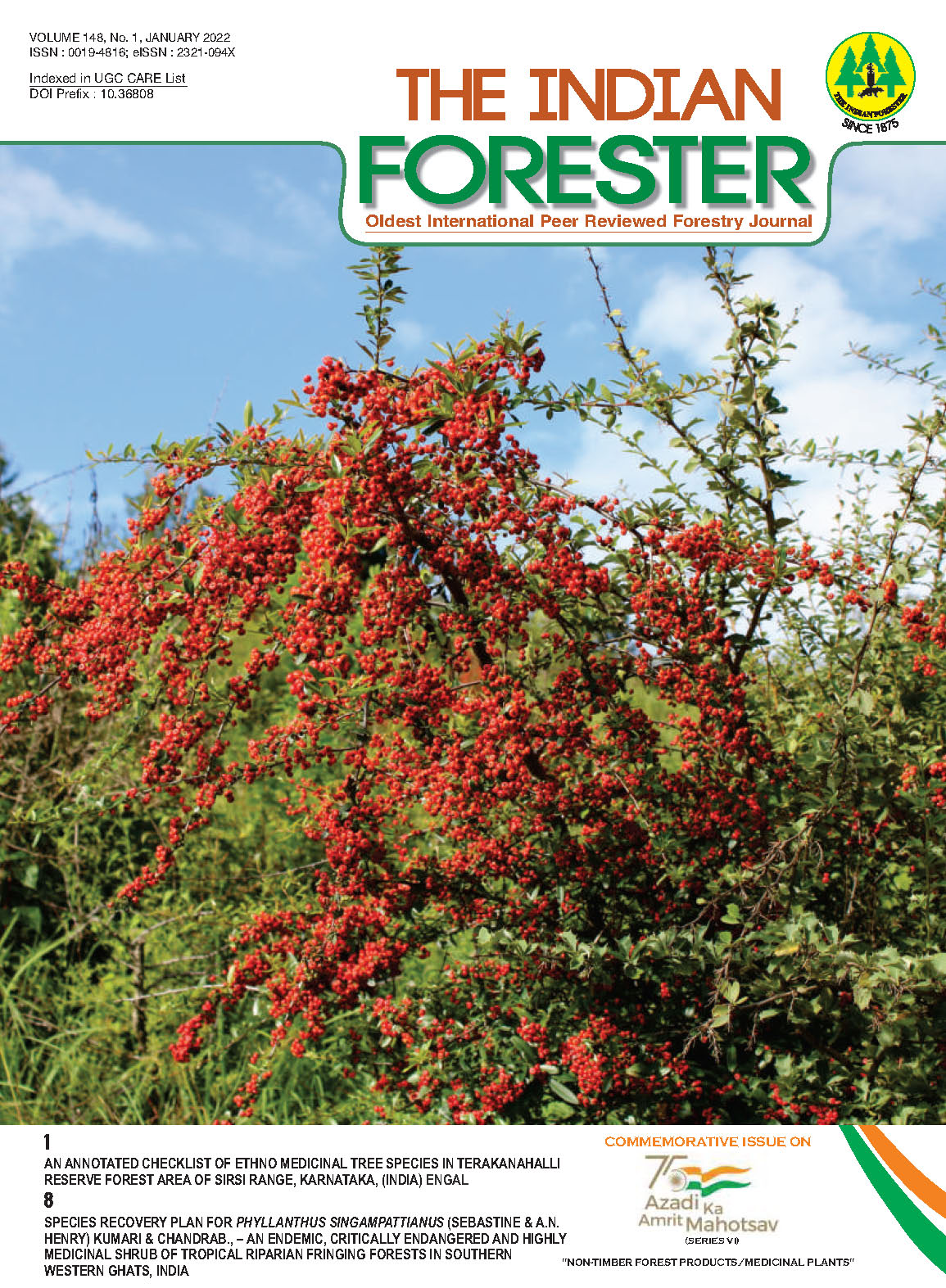Eulophia dabia - A Lesser Known Critically Endangered Terrestrial Orchid
DOI:
https://doi.org/10.36808/if/2022/v148i1/166612Keywords:
Terrestrial Orchid, Eulophia, Pharmaceutical, Ethno-Medicine, Endangered.Abstract
Eulophia dabia (D.Don) Hochr is an endemic and critically endangered, species of the family Orchidaceae. It prefers to grow on sandy soil near water embankments. The tubers of this species are highly medicinal and used by the local healer for the treatment of various ailments. The present paper provides insight of its medicinal utility and their mode of propagation.References
Arditti J.E., Win Yam T. and Glabe C. (1990). The contribution of orchid micorrhizal fungi to seed germination: a speculation review. Lindleyana, 5(4): 249-255.
Bhandari S.R. and Kapadi A.H. (1983). A 9, 10-Dihydrophenanthrne from Tubers of Eulophia nuda. Phytochemistry, 22: 747-748.
Bhandari S.R., Kapadi A.H., Mujumder P.L., Joardar M. and Shoolery J.N. (1985). Nudol, aphenanthrene of the orchids Eulophia nuda, Eria carinata and Eria stricta. Phytochemistry, 24: 801-804.
Christenhusz M.J.M. and Byng J.W. (2016). The number of known plants species in the world and its annual increase. Phytotaxa, 261(3): 201-217.
Cribb P.J. (1989). Flora of tropical East Africa: Orchidaceae (Part 3). Rotterdam: Balkema.
Chauhan N.S. (1990). Medicinal orchids of Himachal Pradesh. J Orchid Soc India, 4: 99-105.
Chauhan S., Pathak P., Anuprabha and Sharma S. (2015) Regeneration of Eulophia dabia through rhizome explants flowering: a study in vitro. J. Orchid Soc. India, 29: 61-65.
Fay M.F. (1994). In what situations is in vitro culture appropriate to plant conservations? Biodivers Conserv., 3:176-183.
Govaerts R., Pfahl J., Campacci M.A., Baptista D. H., Tigges H., Shaw J., Cribb P., George A., Kreuz K. and Wood J. (2015) World Checklist of Orchidaceae. Royal Botanic Gardens, Kew. http://www.kew.org/wcsp/
Hossain M.M., Kant R., Van P.T., Winarto B., Zeng S., and Teixeira da Silva J.A. (2013). The application of biotechnology to orchids. Critical Reviews in Plant Science, 32(2): 69-139.
Hossain M.M. (2015). Ex-vitro seedling development from invitro rhizome like bodies in Eulophia promensis Lindl.: a new technique for orchid propagation. Journal of Botany. http://dx.doi.org/10.1155/2015/207694
La Croix I. and Cribb P.J. (1998). Eulophia. Pp. 458-537 in: Pope, G.V. (ed.), Flora Zambesiaca, 11(2). Kew: Royal Botanic Gardens.
Lee Y-I. (2011). In-vitro culture and germination of terrestrial Asian orchid seeds. 710: 53-62.
Martos F., Johnson S.D., Peter C.I. and Bytebier B. (2014). A molecular phylogeny reveals paraphyly of the large genus Eulophia (Orchidaceae): A case for the reinstatement of Orthochilus. Taxon., 63(1): 9-23.
Masuhara G. and Katsuya K. (1994). In-situ and in-vitro specificity between Rhizoctonia spp. and Spiranthes sinensis (Persoon) Ames. var. amoena (M. Bieberstein) Hara (Orchidaceae). New Phytol., 127: 711-718.
Merchant J.R., Shah R.J. and Hirwe S.N. (1962). Chemical investigation of Eulophia nuda Lindl. Current Science, 31(3): 95.
Narkhede A.N., Kasote D.M. and Jagtap S.D. (2016). Amarkand: A comprehensive review on its ethnopharmacology, nutritional aspects, and taxonomy. Journal of Intercultural Ethnopharmacology, 5(2): 198-204
Nisar M., Khan S.A. and Ali I. (2013). GC-MS analysis and pharmacological potential of fixed oil of Eluphia dabia. MiddleEast Journal of Scientific Research, 14(3): 375-380.
Pant B. (2013). Medicinal orchids and their uses: Tissue culture a potential alternative for conservation. African Journal of Plant Science. 7(10): 448-467.
Pathak P., Bhattacharya A., Vij S.P., Mahant K.C., Dhillon M.K., Piri H. (2010). An update on the medicinal orchids of Himachal Pradesh with brief notes on their habit, distribution, and flowering period. J. Non-Timber Forest Products, 17(3):365-72.
Patil M.C. and Mahajan R.T. (2013). Ethnobotanical potential of Eulophia species for their possible biological activity. Int. J. Pharm. Sci. Rev. Res., 21(2): 297-307.
Pridgeon A.M., Cribb P.J., Chase M.W. and Rasmussen F.N. (2009). Genera orchidacearum, vol. 5, Epidendroideae, pt. 2. Oxford: Oxford University Press.
Rasmussen H.N. (1995). Terrestrial Orchids, from Seed to Mycotrophic Plant. Cambridge University Press, Cambridge.
Rasmussen H.N. (2002). Recent development in the study of orchid mycorrhiza. Plant Soil, 244: 149-163.
Rai I.D., Jalal J.S., Singh G. and Kumar P. (2015). A note on the Occurrence of Eulophia flava (Lindl.) Hook. f. (Orchidaceae) in Kumaon Himalaya. Indian Journal of Forestry, 38(3):263-264.
Sastri B.M. (1952). "The wealth of India" CSIR, New Delhi, 3: 221.
Shekhar N., Promila P. and Sharma K. (2008). Some commercially significant Indian orchids. In: Vij et al. (Eds) Proc. Natl. Conference on Orchids: Science and Society. The Orchid Society of India, Chandigarh, India, pp 4-15
Singh A. and Duggal S. (2009). Medicinal Orchids - An Overview. Ethnobotanical Leaflets, 13: 399-412.
Singh S.K., Agarwala D.K., Jalal J.S., Dash S.S., Mao A.A. and Singh P. (2019). Orchids of India: A pictorial guide. Botanical Survey of India, Kolkata. 548 pp.
Steinfort U., Verdugo G., Besoain X. Mauricio A. and Cisternas M.A. (2010). Mycorrhizal association and symbiotic germination of the terrestrial orchid Bipinnula fimbriata (Poepp.) Johnst (Orchidaceae). Flora, 205: 811-817
Summerhayes V.S. and Hall A.V. (1962). The type species and conservation of the generic name Eulophia R.Br. ex Lindl. Taxon 11: 201-203. http://dx.doi.org/10.2307/1217222
Vij S.P. and Verma J. (2005). Eulophia dabia (D. Don) Hochr.: A new orchid record for Haryana satate, India. J. Orchid Soc. India, 19(1-2): 47-49.
Williamson G. (1977). The orchids of south central Africa. London: Dent & Sons.
Wochok Z.S. (1981). The role of tissue culture in preserving threatened and endangered plant species. Biol Conserv., 20: 83-89.
Downloads
Downloads
Published
How to Cite
Issue
Section
License
Unless otherwise stated, copyright or similar rights in all materials presented on the site, including graphical images, are owned by Indian Forester.





